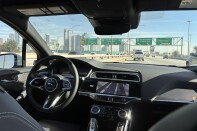Truth matters. Community matters. Your support makes both possible. LAist is one of the few places where news remains independent and free from political and corporate influence. Stand up for truth and for LAist. Make your year-end tax-deductible gift now.
Why California spent $13 million on controversial freeway only to abandon it

Southern California is a land of freeways. We love to hate them, but they help us get around our sprawling car-dependent region.
The state’s aggressive freeway building spree started around the 1950s and mostly survived opposition. But in San Diego County, one freeway got shut down after decades of residents organizing: El Toyon Freeway.
The little freeway that couldn’t
State planners conceived of El Toyon Freeway in the late 1950s as a 1.8-mile stretch between San Diego and National City. Known as State Route 252, the freeway was designed to help ease traffic by connecting the 5 and 805 freeways, cutting straight through the Southcrest neighborhood (known as Shelltown at the time).
El Toyon Freeway was controversial from the start. When the state was clearing land for the route, so many inaccurate rumors circulated that state officials had to set the record straight.
California spent $13 million at the time to seize 66 acres for the right of way, demolishing or moving 280 homes. On-ramps were built, but the actual construction of the freeway lagged. At one point, the California Coastal Commission voted to put a hold on construction for 20 years unless authorities could show the project met air pollution requirements.
Some community members in San Diego opposed El Toyon because they felt it would further divide the predominantly Black and Latino neighborhoods that were already sliced up by freeways, while others in National City were concerned that without the connecting route, traffic would be diverted into their streets.
The debate over El Toyon lasted for decades. Organizers against the freeway would bring in tons of residents to key meetings in an attempt to sway the vote away from transportation interests. It became so intense that an engineer with the state told the San Ysidro Chamber of Commerce in 1973 that El Toyon Freeway was turning into a “white man’s freeway vs. a Black community.”
Activists in San Diego formed the Black Federation with a goal of ending the freeway. Their efforts included researching how clearing the land had damaged the local economy, such lost tax revenue and diminished customer bases.
After much uproar, San Diego officials eventually pulled support of the project in the ‘80s. Nearby cities who had hoped to benefit from the freeway were so frustrated with San Diego that they in turn threatened to pull support from other county projects, including a joint plan for a trash recycling plant.
What became of the abandoned freeway

Despite this, there were still attempts to save Freeway 252. Groups tried to hold the state to its word to build it, and National City fought to preserve the right of way so construction could be possible in the future.
But the state eventually scrapped its plans. Caltrans was ordered to abandon El Toyon Freeway and sell off the land. The on-ramps that had been constructed were turned into a supporting interchange that’s still in use.
The area was slowly redeveloped around the 2000s. Hundreds of homes are once again in the imagined freeway’s place, along with businesses and a school. A Northgate Market now sits next to the interchange.
A public art installation called “A Place to Call Home” at Southcrest Trails Neighborhood Park memorializes the community’s effort to stop the freeway.











